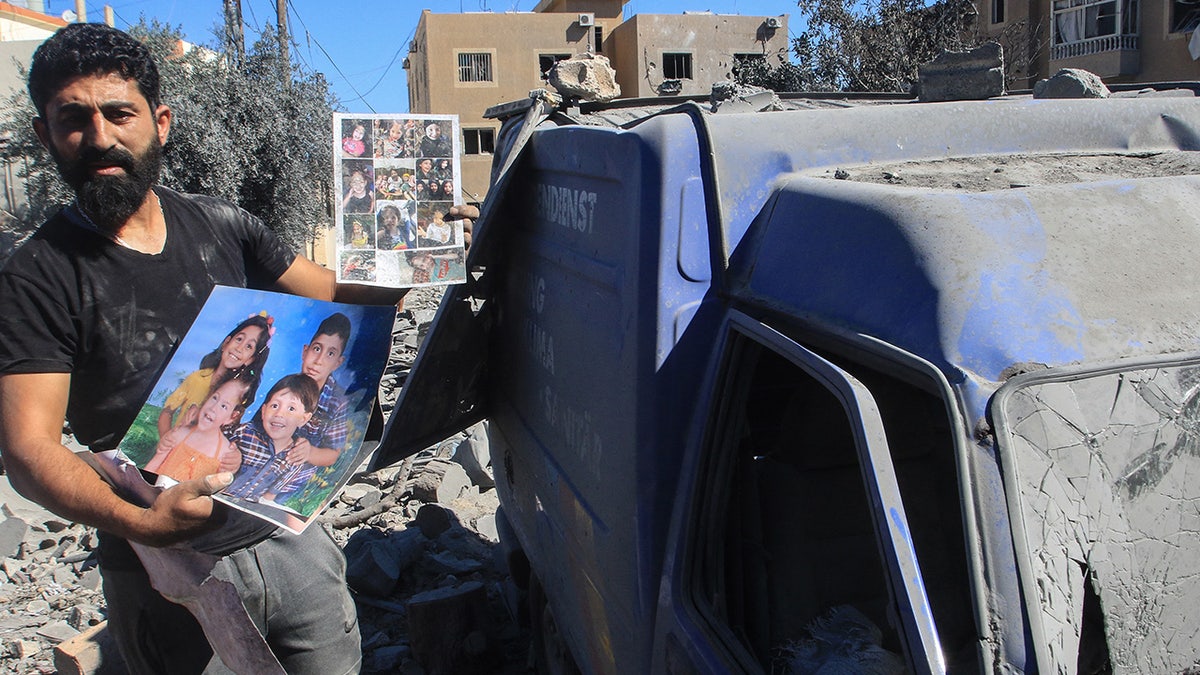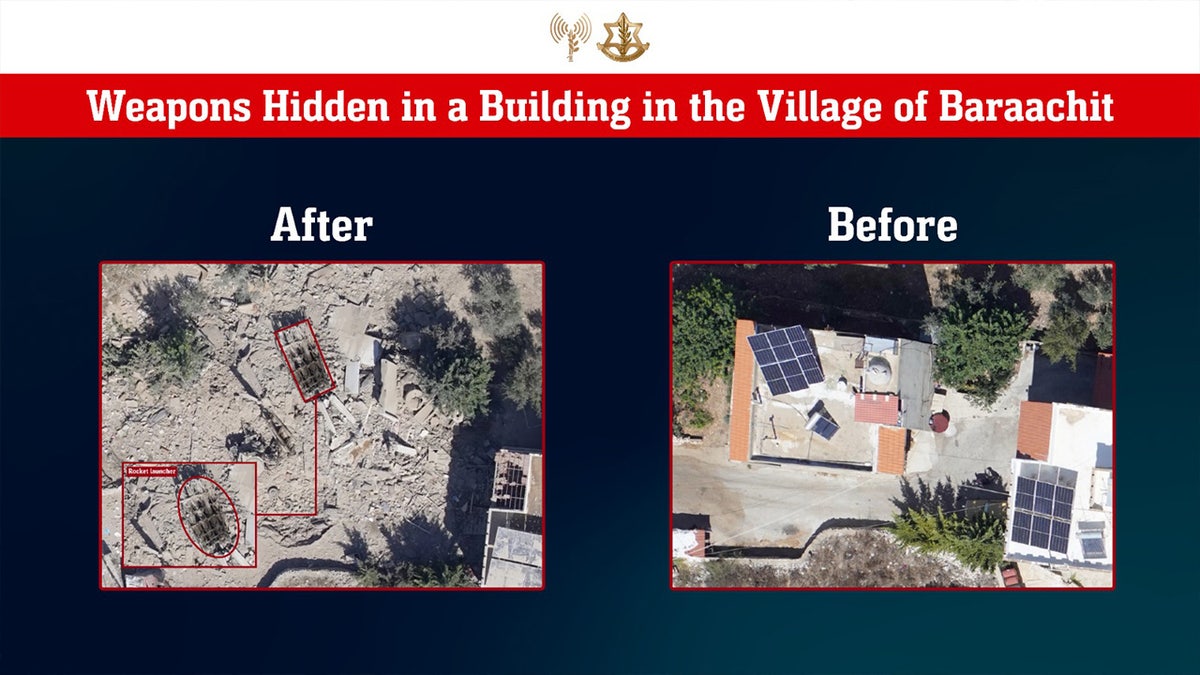Hezbollah keeps weapons from the people of Lebanon, the US says it does not cooperate with the IDF

The war between Israel and Hezbollah has intensified this past month as the Israel Defense Forces (IDF) have begun targeting the terrorist network’s hotspots and military bases, all of which are concentrated in residential areas.
Photos and videos provided by Fox News Digital of recent strikes in southern Lebanon show precision-guided missiles hitting what are believed to be civilian buildings.
Hezbollah’s use of public infrastructure has not only created a complex network of meeting houses, weapons depots and well-concealed missile sites across southern Lebanon and the suburbs of Beirut, it has ensured that the war with Hezbollah cannot be waged without significant collateral damage. .
ISRAEL PREPARING TO PUT THE KINGDOM IN THE FIGHT WITH LEBANON: ‘GET YOURSELF FIXED’
Hezbollah rockets are stored in a building somewhere in Lebanon. (IDF Spokesperson Unit.)
As of Monday, more than 1,800 people have died and 560 people are believed to have died, including 50 children and more than 90 women, according to Lebanon’s Ministry of Health.
On Thursday, the US again urged Israel to agree to a ceasefire in Lebanon, and the Pentagon’s deputy press secretary, Sabrina Singh, confirmed to reporters that the US is not helping Jerusalem militarily or intellectually in its Lebanon-based campaign.
Israeli Prime Minister Benjamin Netanyahu dismissed calls from the international community for a ceasefire and instead ordered his troops to continue fighting “with full force.”
French President Emmanuel Macron on Wednesday warned Israel that “it will not without consequences simply increase its operations in Lebanon” as authorities on the Israel-Lebanon border ordered its troops to “prepare” for a possible attack on the ground.
No attacks have been ordered at this time, although Israeli and American security experts told Fox News Digital that the network Hezbollah has built on the foundations of everyday life in Lebanon means a war with the terrorist network will likely be costly in human terms. life than what has been witnessed in Gaza.

Smoke rises from Israeli airstrikes on villages in the Nabatiyeh region, seen in the southern city of Marjayoun, Lebanon, Monday, September 23, 2024. (AP Photo/Hussein Malla)
According to the Israel-based Alma Research and Education Center, a non-profit organization that studies Israel’s security challenges along the border with Lebanon, Hezbollah has long relied on the use of civilian infrastructure to meet its needs.
ISRAEL-HEZBOLLAH WAR: NETANYAHU ‘NEVER EVEN RESPONDED’ TO FIRE SUPPORT AGREEMENT, COMMITS TO FIGHT ‘WITH FULL POWER’
“The phenomenon of renting houses, rooms, warehouses in Shiite neighborhoods by Hezbollah has been known since the early 2000s,” Tal Beeri, head of the research department in Alma, told Fox News Digital, adding that terrorists also rent. properties in non-Shia areas of Lebanon as well.
“The proof of this matter was found in the looted documents and the investigation of Hezbollah employees during the Second Lebanon War in 2006. Since then, Hezbollah has accelerated this situation and estimates say that all three houses in southern Lebanon have been used by Hezbollah for its needs. ,” he added.
Beeri shared research with Fox News Digital that showed findings from 2021 breaking down the complex system in which Hezbollah is involved in the day-to-day operations of local villages across the country.

A man shows photos as people sift through the rubble of a building in the target area of overnight Israeli airstrikes in the Lebanese city of Saksakiyeh, September 26, 2024. Israel on September 26 rejected a push led by its main ally the United States on a 21-day ceasefire in Lebanon, as it vowed to continue fighting Hezbollah terrorists “until victory.” (Photo by MAHMOUD ZAYYAT/AFP via Getty Images)
Hezbollah officials named “Rabat” – loosely translated as “communication” – are installed in the villages of Lebanon and work as a representative of the terrorist group, serving the needs of the citizens in cooperation with the hyper-localized activities of Hezbollah.
Rabat, which presides over many villages, is reported to be establishing relations with citizens by making requests for assistance such as money, food and territorial disputes.
“In areas where Hezbollah decides to expropriate or rent land or buildings from residents for the purpose of its military activities, ‘Rabat’ carries out the process of land confiscation or leasing in consideration of the appropriate resident,” Beeri found.
The report, based on documents taken after the 2006 war with Hezbollah, found that Rabat also recommended local Hezbollah units the best places in each city “ready to use the human shield strategy” based on the last needs around hiding, infrastructure. type and placement of weapons.

The photos show civilian buildings used by Hezbollah in Lebanon to store weapons. (Photo courtesy of Israel Defense Force)
Rabat then liaises between the terrorist organization and the local landlord.
“‘Rabat’ is strengthening Hezbollah’s grip on the daily lives of Lebanese residents, their property, and their needs, allowing Hezbollah to turn people’s shields on a large scale,” the report found.
Hezbollah’s control over local communities and its ability to collect and transfer weapons throughout the country through a complex tunnel system show that UN Resolution 1701 passed in 2006 to prevent a third war between the terrorist network and Israel has failed.
CLICK HERE FOR THE FOX NEWS PROGRAM
Although it is not clear whether the members of the UN Security Council are looking to renew the resolution to fight the movement of the terrorist group and stop the Israeli operations in the occupied areas, the international community has called on Netanyahu to stop his campaign – many leaders from both enemy and allied nations, have seriously warned against the attack Lebanon.
Netanyahu is expected to address the UN body on Friday in what Israel’s UN ambassador described as the most “hateful” situation he has seen in his nearly 10 years of attending the conference.
Source link




